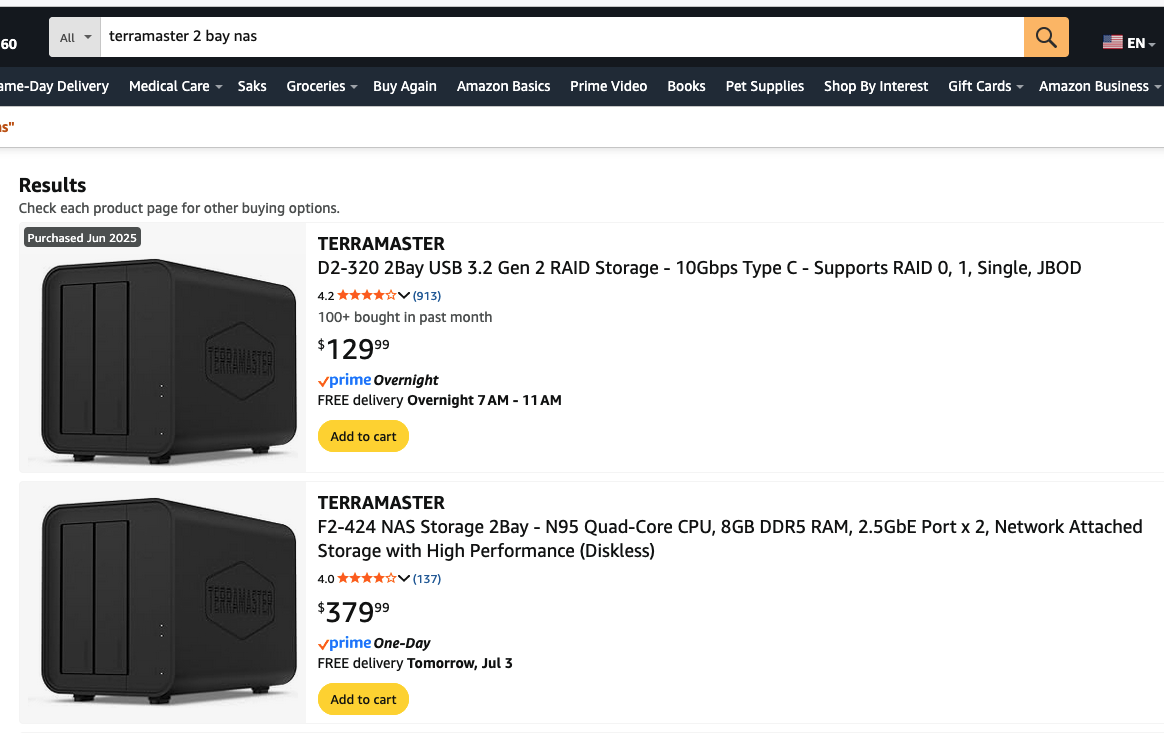…matic. ok I’ll stop, sorry
guh! I thought it’d be nice to have my one source of truth for all my data I care about. I can reference it from anywhere, and it’ll back up to The Cloud. Plus, music server.
It was more of a pain than I expected!
buying the right stuff
I searched for a NAS and bought one. Well, I thought I did. You’ll have to forgive me for thinking this first result was a NAS, given the search terms and all the rest of the results:

I guess I should have noticed it was very cheap. Alas: it was a hard drive enclosure. Well. Returned it and bought a QNAP TS-216G-US.
Luckily I did the HD just fine: a 1TB Western Digital NAS SSD123.
Got a UPS with AVR while I’m at it, since our @&*$%#! grid means we lose power more often these days.
dive into bizarro software world
I didn’t really think about it, but buying a QNAP NAS is really buying a QNAP El Cheapo Computer running QNAP OS, which means you get more-or-less whatever software they have made available for QNAP OS.
Setting it up is more of a thing than I’d guessed! you connect through guessing its address on your LAN, then you can set up “MyQNAPCloud”? You have to choose all sorts of setup things like do you want a “thin volume”, “thick volume”, or “static volume” on your hard drive? Gah
Then you’re in its knockoff-Windows GUI, f’ing everything has a splash screen Wizard, and you go through their App Center stepping over 19 different Backup/Sync apps, 11 “Entertainment” apps such as “Kazoo Server”, a lil category called “Surveillance”, …
Luckily “HBS Hybrid Backup Sync”, the preinstalled backup app, let me set up the following syncs easily:
- from Google Drive to NAS (real-time)
- from Dropbox to NAS (real-time)
- from NAS to Glacier (nightly)
access my files
On my local network at home, I can go to 192.168.1.76 and find the NAS. I don’t know why it’s .76. I don’t even remember how I found it the first time when I plugged everything in and then went “now what?”
I can get there via myqnapcloud.com. Then that gives me a “smart URL” that’s https://qlink.to/(my nas name). Most importantly, I can access it like a HD, I think, on my local network or once I set up a VPN. More on that later.
(I’m sure there’s some way I can ssh? I hope? geez I didn’t even get this far yet)
jellyfin again
Jellyfin lets you stream your music from anywhere. Plex does too, but they’re getting worse over time and charging Yet Another Subscription, while Jellyfin remains free. Alas, free also sometimes means pain in the ass.
(I originally wanted to buy from Terramaster, the #3 NAS company, because they don’t lock you in to their HDs like Synology, and they advertise Jellyfin built-in. but I figured QNAP, the #2 NAS company, would be just as good, and how hard can installing software be? alas)
Anyway someone made an app you can install for QNAP Janky OS, and it seems to work, hooray
The last bit I can’t figure out is how to get it to serve jellyfin over https or install tailscale. The jellyfin-qnap maker wrote a series of incantations that did not work, though it’s probably my fault, because I did the usual “forget about certificates for 6-12 months, let all knowledge leave my brain, then try to learn about them again.”
ach, vpn
I can skip all this https nonsense if I use a VPN!
- Attempt 1: there is a Tailscale QNAP app! But doesn’t work for my NAS version! Gah.
- Attempt 2: there’s the “QVPN” app which lets you set up an OpenVPN connection. Or a L2TP/IPSec connection. Claude guided me through all these settings, all the ports to open, all the troubleshooting, it didn’t f’ing work.
- Attempt 3: install Tailscale from container. The only setting I had to change (thanks Claude) was to run it in “Network mode: Host.” It worked! As soon as I logged in, the logs gave me a little URL to go to to log in to my tailscale account. Then it’s a machine on tailscale just like any other. Hell yeah. So I can access it when I’m not at home, use Jellyfin without fear of exposing a public http port, and even mount it as a regular hard drive.
Why SSD? I guess I could have bought a 3.5" HDD: cheaper and bigger. But I have small data requirements (200Gb-ish), I still have it in my mind that “SSD is better”, and no spinning disks means slightly quieter I guess. ↩︎
why only 1TB? much like house storage, the amount of junk you have scales with your available space ↩︎
why not 2 drives set up as RAID? I guess I like the idea of 2 backups: one local exact copy for when the HD dies, and one on AWS in case our house burns down. but this feels maybe a bit paranoid: the odds that Amazon dies the same time my HD does seem very low. IF I do test my backup and recovery. Which I will. Of course. ↩︎
blog 2025 2024 2023 2022 2021 2020 2019 2018 2017 2016 2015 2014 2013 2012 2011 2010